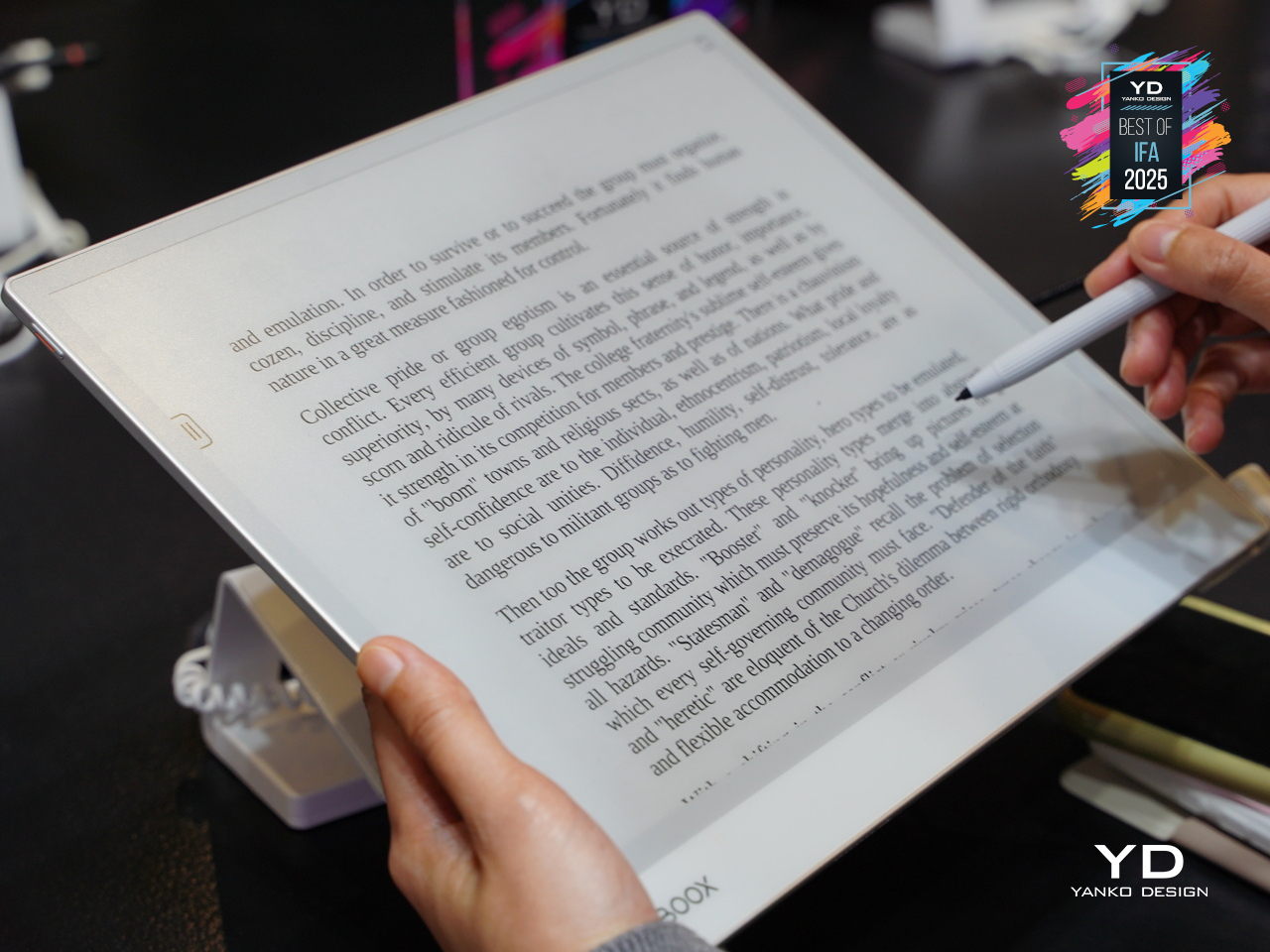Design Philosophy: When Automotive Thinking Meets Micromobility
![]()
Rivian didn’t simply add another e-bike to the market. Through their new ALSO spinoff, they applied automotive-grade engineering to reimagine what two-wheeled transportation could become when stripped of mechanical constraints. The TM-B e-bike represents a fundamental shift in how we think about pedal-powered vehicles, replacing century-old drivetrain conventions with a software-defined riding experience.
Designer: Rivian
What emerges is a platform for modular micromobility that prioritizes adaptability over specialization. The design philosophy centers on one radical premise: remove the mechanical connection between pedaling and propulsion, then rebuild the entire vehicle around what becomes possible.
Proportions Freed from Mechanical Constraint
Traditional bicycle design bows to the demands of mechanical drivetrains. Chains dictate frame geometry. Derailleurs determine clearances. Gear ratios constrain wheel sizing. The TM-B dismisses these limitations entirely.
![]()
The pedal-by-wire system, which Rivian calls DreamRide, severs the physical link between your legs and the wheels. When you pedal, you’re powering a generator. That energy charges the battery, which then drives a motor at the rear wheel. The implications for design freedom are profound.
Frame tubes can be sized for structural efficiency rather than mechanical routing. Standover height becomes a pure ergonomic decision. Wheel placement optimizes handling instead of accommodating chain length. The entire architecture flows from rider needs rather than mechanical requirements.
Full suspension with 120mm travel front and rear creates spatial generosity in how the bike absorbs terrain. Those gold-anodized stanchions aren’t just premium visual cues, they signal a riding experience tuned for urban chaos and trail exploration equally.
Modular Surfaces: One Frame, Multiple Identities
The top frame isn’t fixed structure but rather a design canvas that transforms the vehicle’s purpose in seconds. This modularity enables three distinct configurations without tools or complex adjustment procedures.
![]()
Swap in a solo seat configuration, and the TM-B becomes a personal urban runner with dual water bottle mounts. The proportions read athletic, lean, focused. Slide in the bench seat instead, and suddenly spatial relationships shift. The bike lengthens visually. Room for a passenger or substantial cargo alters how you perceive the vehicle’s stance and capability.
Mount the utility cargo rack, and form follows function most overtly. That 77-pound capacity reshapes what this platform enables: grocery runs, equipment transport, daily errands that traditionally demanded four wheels. The transformations require no tools. Seconds to swap. The design intelligence lies in creating attachment points that disappear when not in use while providing industrial-grade strength when loaded.
Each configuration tells a different spatial story while maintaining design coherence. The frame proportions accommodate all three personalities without compromise.
Material Reduction Through Digital Shifting
Eliminating the mechanical drivetrain removes visual and tactile complexity from the entire right side of the bike. This creates unprecedented surface cleanliness that most e-bikes can’t achieve because they still rely on traditional bicycle components.
![]()
No derailleur hanging vulnerably from the dropout. No cassette stack creating width at the rear wheel. No chain requiring guards, maintenance, or lubricant. The Gates carbon belt drive (on the pedal input side) delivers power silently and permanently to the generator, not to the wheel directly. It’s designed to outlast the bike itself with zero maintenance intervals.
This material reduction extends to the cockpit. Traditional bikes clutter the handlebars with shifter pods, brake levers, and sometimes throttle controls. The TM-B consolidates everything through a central touchscreen that floats between the grips. Gear selection happens through software, not mechanical clicking. Ten levels of pedal assist adjust seamlessly. Sport, Trail, All Purpose, and Conserve modes reshape the riding character without adding physical controls.
The visual result is clean surfaces throughout. The bike reads as intentionally minimal rather than stripped down, because the design removed complexity rather than hiding it.
Battery Architecture as Design Element
Most e-bikes conceal batteries within frame tubes, prioritizing invisibility over accessibility. The TM-B makes power storage a designed interaction.
Two removable battery options (538Wh and 808Wh) twist free without tools. The larger capacity delivers 100-mile range, extraordinary for a vehicle this size. But range becomes secondary to the design thinking behind making batteries user-facing rather than integrated.
![]()
USB-C charging at up to 240W means these packs double as portable power banks. The batteries become part of your broader electronic ecosystem rather than single-purpose components. Pull a battery, charge your laptop at a coffee shop, return it to the bike. The design acknowledges that modern urban life revolves around managing multiple devices, not just transportation.
![]()
An e-ink display on each battery provides status without requiring phone connectivity, giving you physical feedback and immediate information. This creates designed confidence where you know exactly how much range remains before needing to swap or charge.
Lighting Rituals: Biomotion Safety
Integrated lighting typically means front and rear LEDs that meet minimum legal requirements. The TM-B’s lighting philosophy comes from automotive safety research.
Biomotion lighting highlights the rider’s body movement (head, arms, legs) rather than just illuminating the bike’s extremities. Studies show that drivers recognize moving human forms faster than static vehicle shapes, especially in peripheral vision. The lighting system transforms the rider into a more recognizable threat that drivers process earlier.
![]()
This isn’t decorative accent lighting but rather lighting as designed protective intervention. It borrows from decades of automotive human factors research and applies it to two-wheeled vulnerability.
Security Through Remote Architecture
Physical locks represent designed failure. Cable locks cut easily. U-locks require carrying bulk. Frame locks add weight. The TM-B makes theft functionally pointless through software architecture.
When you walk away, the bike automatically locks the battery, wheels, and frame. Not physically, but electronically. Attempt to ride a locked TM-B and nothing responds. The motor won’t engage. The battery won’t discharge. The entire vehicle becomes an expensive sculpture.
Remote bricking takes this further. Report a bike stolen, and ALSO can disable it remotely. The bike becomes worthless to a thief: not resellable, not rideable, not even useful for parts. Security becomes invisible, permanent, and comprehensive without adding physical bulk or weight.
Regenerative Braking as Range Extension
Hydraulic disc brakes handle primary stopping. But regenerative braking captures energy during deceleration and feeds it back to the battery.
The design outcome: up to 25% range extension from energy that typically dissipates as heat. It’s not dramatic enough to feel like engine braking in an EV car. It’s subtle, seamless, almost unnoticeable, which represents successful design integration rather than engineered compromise.
![]()
The system demonstrates how automotive EV thinking translates to micromobility. Every descent, every slow-down, every controlled deceleration becomes an opportunity to extend range without conscious rider input.
Manufactured Variants as Design Personas
Three trim levels don’t just offer different equipment but represent distinct design philosophies about what this platform should express.
The Launch Edition ($4,500, spring 2026) introduces the concept with unique blue, purple, and other launch finishes that communicate newness and differentiation. It’s ALSO announcing they’ve arrived with something visually distinct.
The Performance trim (same price, summer 2026) adds air suspension and higher output motor specs. Design shifts from introduction to capability. This version targets riders who prioritize dynamic range over value positioning.
![]()
The Base model (under $4,000, late 2026) strips back to essentials with 60-mile battery and simplified spec. The design message becomes accessibility: getting this platform’s core benefits to wider audiences without the premium finish work.
Each trim tells a clear story about who this bike serves and why. The pricing strategy keeps Performance and Launch identical, making the choice about timing and aesthetics rather than value hierarchy.
The Quad Evolution: Four-Wheeled Platform Thinking
ALSO’s roadmap extends beyond two wheels to pedal-assisted quads designed for cargo delivery.
The TM-Q vehicles represent the same core philosophy applied to different constraints. Remove mechanical drivetrain limitations. Build software-defined platforms. Enable modular transformation. Optimize for bike lane operation rather than automotive infrastructure.
![]()
The design thread connecting the TM-B and TM-Q products is platform thinking: creating foundational architecture that supports multiple form factors rather than designing discrete vehicles. It’s how automotive manufacturers approach product development, now applied to micromobility at urban scale.
Form as Manifestation of Vertically Integrated Engineering
The TM-B doesn’t source components from Shimano, Bosch, or other e-bike suppliers. Rivian developed the battery, motor, electronics, and software in-house. This vertical integration enables design decisions impossible with off-the-shelf components. Where most e-bikes still rely on partial automotive supplier components, Rivian’s approach is pure ground-up integration applying full automotive engineering rigor to two-wheeled transport.
The pedal-by-wire system exists because Rivian controlled the entire drivetrain stack. The security architecture works because they own the software. The battery packaging succeeds because they designed the cells and the enclosures simultaneously.
What you see in the TM-B’s form is the physical manifestation of engineering control. Proportion and surface decisions made possible only when every component answers to a single design vision rather than marketplace constraints.
![]()
Over-the-air updates will refine this bike’s behavior throughout its life. The riding characteristics you experience at delivery represent a starting point, not a fixed state. Software-defined vehicles evolve. The TM-B’s design accommodates continuous improvement rather than planned obsolescence. Service and repairs happen at Rivian’s automotive service centers, not traditional bike shops, treating the TM-B as an extension of their vehicle ecosystem.
Why This Matters for Design
The ALSO TM-B demonstrates what becomes possible when automotive engineering rigor meets micromobility scale. It’s not about making bikes more expensive or complex but about removing century-old mechanical constraints and rebuilding around what riders actually need.
Modular transformation without tools. Batteries as portable power rather than hidden components. Security through software instead of physical locks. Drivetrain without mechanical compromise. Lighting that makes riders more visible through human factors research rather than brighter bulbs.
Rivian took their EV platform thinking (vertical integration, software-defined experiences, continuous improvement through updates) and scaled it to two wheels. The result challenges what we accept as inevitable in bicycle design.
The TM-B isn’t trying to be a better traditional bike. It’s showing what happens when you throw out the script entirely and rebuild from first principles. That’s what makes it worth studying, regardless of whether you ever plan to buy one.
The post Design Philosophy: When Automotive Thinking Meets Micromobility first appeared on Yanko Design.


